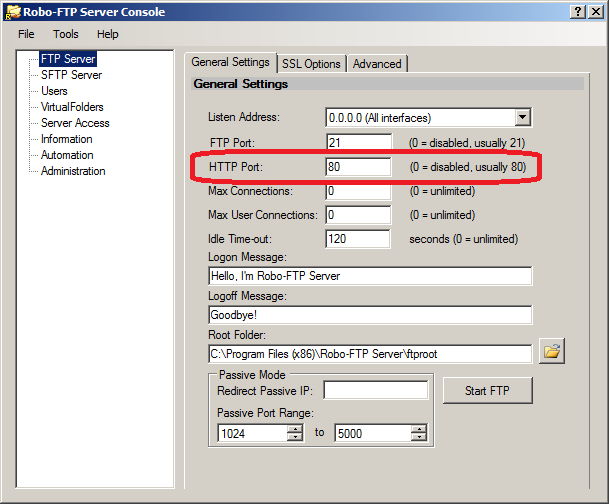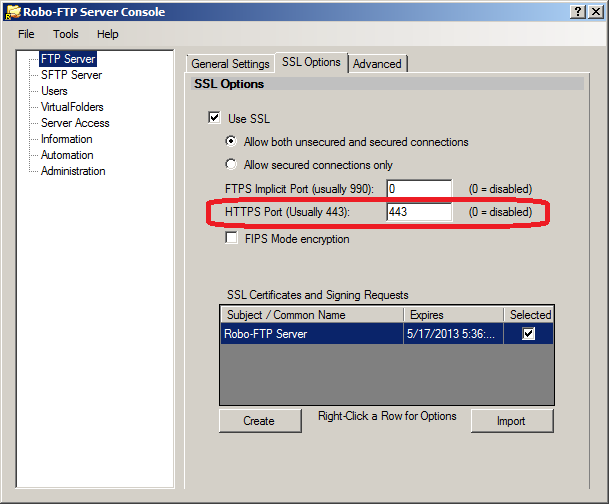Robo-FTP Server includes support for HTTP and HTTPS file transfers. The HTTP support works with a web browser for browsing and downloading files. You can also use any DAV enabled HTTP client to perform all the standard webDAV functions, such as making directories, deleting files or folders, uploading and downloading files, and listing directory contents.
WARNING: This feature is enabled during the 30-day trial evaluation but an Enterprise license is required to use this feature on an ongoing basis.
HTTP is enabled on port 80 by default. HTTP may be disabled or run on another open port by changing the HTTP Port value on the "General Settings" tab of the FTP Server menu in the Robo-FTP Server Console.

HTTPS access is enabled on port 443 by default. HTTPS may be disabled or run on another port by changing the HTTPS Port value on the "SSL Options" tab of the FTP Server menu in the Robo-FTP Server Console.

Default Pages
If Robo-FTP Server receives an HTTP Request from a web browser that includes a valid directory name as the URL then it will automatically return the index.html file from that directory. If the directory does not contain an index.html file then Robo-FTP Server will reply using a template named listdir.html located in the program installation folder under \ProgramData\templates instead. It is possible to modify this template file to change the appearance of directory listing pages returned when no index.html file is present. You could replace the template with a new HTML file that is not a directory listing or you can modify the existing template's HTML while preserving the <serengeti:listing_header/> and <serengeti:listing/> placeholder plugs. When Robo-FTP Server finds those tags in the listing.html template file it replaces them with the folder name and a list of files. If no index.html is found in the directory, and no listdir.html template is found under \ProgramData\templates, Robo-FTP Server will return a listing based on a default, internally-defined template.
If Robo-FTP Server receives an HTTP Request for a valid directory from a program that is not a web browser it returns a machine-readable directory listing. Robo-FTP Server determines if a request was submitted by a web browser by looking for the word "Mozilla" in the Request header value named "User-Agent."
Uploading Files using HTML Forms
When Robo-FTP Server receives a POST Request that includes form elements of type "file" it saves the files to the directory specified as the target of the POST. For HTTP requests that include valid directory names, as above, Robo-FTP Server can provide a convenient upload form for uploading data to the current directory. The upload form is itself a template named upload_form.html located in the program installation folder under \ProgramData\templates. If no upload_form.html template can be found, Robo-FTP server will use a default, internally-defined template. You could also replace this upload form template with one of your own choosing to customize the uploader as needed. The upload form template can be included in the listdir.html template using the following placeholder plug: <serengeti:upload_form/>. If this placeholder plug is removed from the listdir.html template, no upload form will appear.